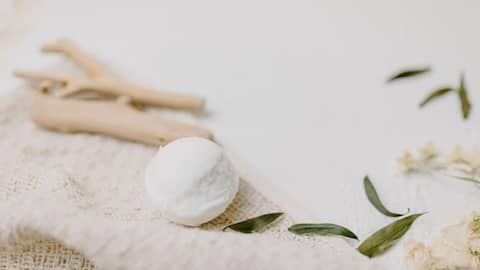Simple DIY bath bomb to fancy up your daily routine
What's the story
After a long, stressful day, nothing beats a relaxing soak, especially when enhanced with a homemade bath bomb. These delightful spheres, made from a blend of soothing oils and enchanting scents, fizz and dissolve in warm water, leaving your skin silky and smooth. Lift your mood and your daily routine with this simple DIY bath bomb recipe that lets you customize your relaxation experience.
Ingredients
What you'll need
To start on your bath bomb crafting process, gather one cup baking soda, half a cup citric acid, half a cup cornstarch, half a cup Epsom salt (optional), two teaspoon essential oil (eucalyptus, rose, or lavender), two tablespoon emollient oil (coconut, jojoba, or sweet almond), a few drops of food coloring, a mold, decorative accents, and basic tools like a whisk and mixing bowls.
How to make
How to make a bath bomb
Combine dry ingredients in one bowl and wet in another. Slowly merge the oil mixture into the dry ingredients, whisking continuously and adding drops of water. If adding decorative accents, place them in the mold before firmly pressing in the mixture. Leave the bath bombs in the molds for four hours, and your personalized creations are ready to fizz away in your tub!
Tips
Decorative accents and molding tips
Enhance your bath bombs by incorporating rose petals or orange peels. Ensure the mixture clumps together when pressed; it should not be too wet. Work swiftly, as water activates the fizzing reaction. Allow the bath bombs to set in the molds for two to four hours before removal, then enjoy the satisfying fizz as they dissolve in your bath.
Safety
Choosing safe ingredients
When making bath bombs, it is crucial to be mindful of the ingredients you pick. Essential oils like tea tree, lemongrass, sandalwood, and clove should be handled with care, especially around children. Dilute essential oils in carrier oils to minimize the risk of skin irritation. Additionally, some citrus oils may cause a photo-toxic reaction in sunlight, so caution is advised.
Careful
Safe usage of baking soda and cornstarch
Baking soda and cornstarch are generally safe for bath bomb recipes. Both ingredients, whether dry or dissolved in water, pose minimal risks. Baking soda, a mild base, creates a gentle alkaline solution in water. The concentration of baking soda in a typical bath bomb recipe remains low and ensures a safe and enjoyable bathing experience.
Citric acid
The fizz factor: Benefits of citric acid
The magic of bath bombs lies in citric acid, creating a fizzy spectacle. As explained by experts, when citric acid reacts with baking soda in the bath bomb, it releases carbon dioxide, resulting in an effervescent and entertaining effect. Embrace the fun side of bath time with this dynamic duo that turns your ordinary soak into a bubbly adventure!
